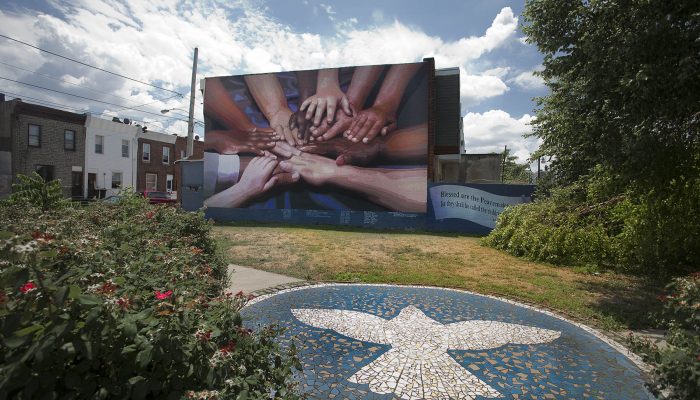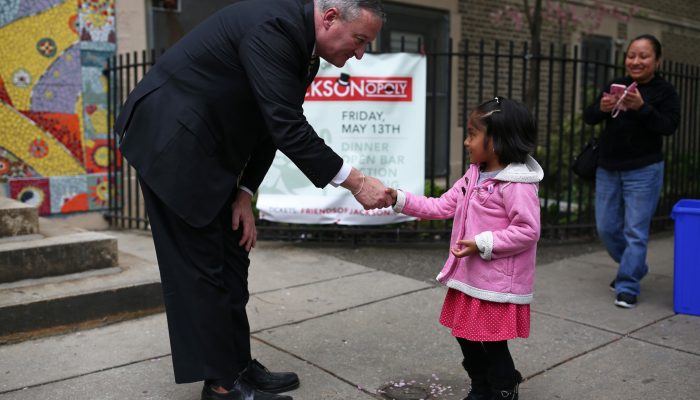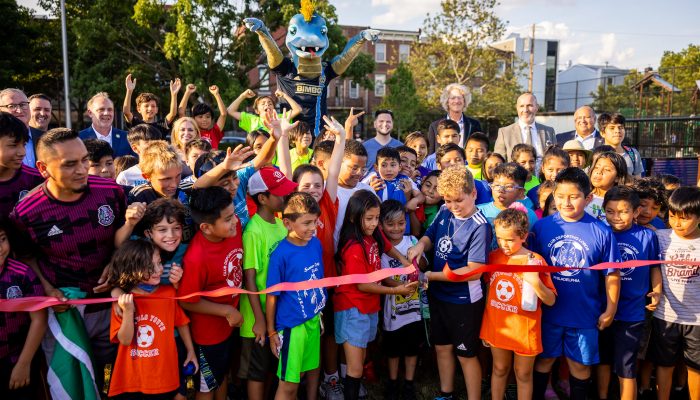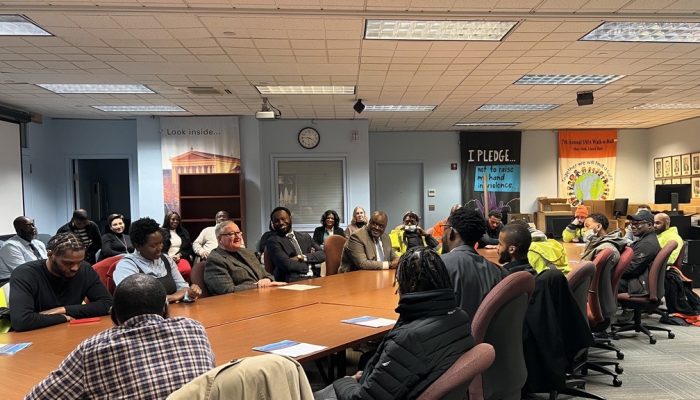In recent weeks, the City has published a series of reports detailing progress on a range of key issues over the eight years of the Kenney administration, as well as offering recommendations to sustain the City’s momentum in these areas.
Here we offer the following report on gun violence and the City’s ongoing effort to reduce its devastating impact on victims, families, and all Philadelphians. While the City has devoted an unprecedented level of resources to reducing gun violence, there remains much more to do. Even with the magnitude of work to be done, the programs and strategies implemented throughout the Kenney administration are producing positive results. In this report, the City provides an update on its comprehensive approach to reducing gun violence in Philadelphia.
A national perspective
The rise in gun violence in Philadelphia since 2020 reflects a trend that occurred nationwide:
- A recent study showed that gun deaths rose 43 percent in America’s big cities during the COVID-19 pandemic, with an estimated 22 gun deaths occurring daily in these cities at the pandemic’s height in 2021.[1]
- There were 690 mass shootings (defined as incidents where more than four people were shot) nationwide in 2021 and 647 more in 2022.
- There were 21,009 total gun deaths in America in 2021, and another 20,200 gun deaths last year (not including suicides).[2]
Although the cause of the increase during the pandemic is still not fully understood, “[t]he proliferation of guns has been particularly lethal for densely-populated urban communities that have been subject to years of structural inequities, and underinvestment, and a lack of opportunities for young people.”[3]
The crisis and response in Philadelphia
While many other cities have experienced significantly higher homicide rates than Philadelphia,[4] the impact of gun violence has been no less devastating here. In 2022 alone, 506 people were fatally shot, and 1,831 were wounded.[5] Victims, families, and communities have been traumatized. In 2022, 65 percent of Philadelphians reported hearing gunshots in their neighborhood during the previous 12 months.[6]
In response, the Kenney administration and City Council made reducing gun violence their top priority, and the City, in the last two years alone, has committed an unprecedented level of financial resources to this crisis, including significant additional support for law enforcement, new policing strategies, and a comprehensive range of violence prevention and community wellness initiatives to address the issue. The strategy is built on the adoption of evidence-based solutions and innovative initiatives tailored to the shifting dynamics of gun violence and also prioritizes sustainable solutions that will foster long-term violence reduction.
These efforts are showing positive results, with homicides in Philadelphia down by 26 percent since 2021[7] and shootings overall down 22 percent citywide[8] compared to previous year-to-date totals.
The City’s Roadmap to Safer Communities
The City’s strategy for addressing gun violence predates the pandemic. In early 2019, Mayor Kenney launched a comprehensive strategy to tackle the issue, known as Philadelphia’s Roadmap to Safer Communities. Focused on the root causes of violence, including the undeniable role of structural racism, poverty, and disinvestment in underserved communities, the City has taken a public health approach that includes four basic pillars:
- Connected & Thriving Youth, Young Adults & Families
- Coordinated City Services & Planning
- Strong Community Engagement & Partnerships
- Safer & Healthier Neighborhoods
In the wake of the dramatic rise in gun violence during the pandemic, the Roadmap strategy became the framework for the historic increase in City funding to address the issue.
Historic investments to save lives
In Fiscal Years 2022 and 2023, the Kenney administration and City Council invested a combined total of $346 million to combat gun violence – more local tax revenue than any administration in the history of Philadelphia. In Fiscal Year 2024, the City is projected to spend an additional $250 million for this purpose.
Community-based programs
This dramatic increase in City funding supports the launch or expansion of a comprehensive range of community-based anti-violence initiatives, including:
- Group Violence Intervention (GVI): GVI is a “focused deterrence” program that identifies groups (people who associate and commit crimes together) and engages members directly to offer help – a job, a needed City service – while also stressing the consequences if the violence continues. Launched during the height of the pandemic, GVI is based on research showing that in many cities as much as 70 percent of shootings and homicides are committed by just .5 percent of the city’s population [9]. GVI pairs community members (often including the mothers of gun violence victims) with law enforcement representatives and case managers to conduct outreach, providing a “moral message” approach that is effective in reaching its high-risk targets, many of whom have fallen through the cracks of society. Because of its success to date, officials and communities across the country and globe – including Miami, Jacksonville, Austin, New Haven, Louisville, and Sweden – have come to Philadelphia to observe and learn from Philadelphia’s implementation of GVI. Originally budgeted for $1.4 million in Fiscal Year 2022, GVI’s budget increased to $3.8 million for both FY2023 and FY2024.
- Community Crisis Intervention Program (CCIP): Launched in 2018, CCIP employs a “credible messenger” approach to conduct outreach, modeled after Philadelphia’s pioneering Crisis Intervention Network. It focuses on individuals at high risk of shooting someone or being shot, offering support to reduce tensions, mediate conflicts, and provide critical City services. With the appointment of a new staff director this year, CCIP remains an important asset in the City’s violence prevention efforts. The City invested $5.15 million in CCIP in FY2022, which increased to $6.5 million in FY2023 and FY2024.
- Pushing Progress Philly (P3): Launched as a pilot program in the spring of 2023, the P3 program – based on the acclaimed READI Chicago model – pairs relentless outreach to high-risk young men with behavioral health interventions, such as cognitive behavioral therapy, and transitional jobs and job training.
- Community Expansion Grants: Designed to support community-based groups working to reduce violence in their own neighborhoods, Community Expansion Grants (CEG) fund more than 50 local groups in neighborhoods at the highest risk of violence. The first cohort of grantees were awarded $13.5M in funding.
- Hospital Violence Intervention Program (HVIP): Launched in partnership with all six of the City’s leading Level One Trauma Centers Violence Intervention Programs, the Collaborative brings together these acclaimed programs that support victims and families after hospitalization for their wounds by providing wraparound services to help victims and families recover from gun violence. This year, the Collaborative coordinated an ongoing pilot of guaranteed basic income for survivors of gun violence from hospital-based violence intervention programs across the City.
- Violence Interruption Coalition: This citywide group meets monthly to discuss trends, share results, and identify new ways to better coordinate the City’s anti-violence initiatives.
- Firearm Homicide Review Coalition: Bringing together multiple City departments and agencies involved in anti-violence programs, the Coalition convenes to examine the causes of gun violence and identify ways to implement community interventions.
- Juvenile Assessment Center: Focused on high-risk youth, the JAC provides an alternative processing center for at-risk youth aimed at reducing time in custody and identifying alternatives to detention where appropriate.
- Police-Assisted Diversion: PAD is designed to divert low-level, non-violent, drug, prostitution, and retail theft offenses away from the criminal justice system and towards supportive, customized peer-based social services.
Trauma-informed innovations
In addition to community-based initiatives, the City also launched:
- 988/Philadelphia Crisis Line: The city’s behavioral health hotline that provides 24/7 crisis and emotional distress intervention has expanded to also include crisis counselors that are embedded into the City’s 911 radio room to handle behavioral health calls. In 2022, Philadelphia’s program became the model for the national 988 network of crisis support centers.
- 2-1-1 Violence Prevention Hotline: The City launched a 24-hour 2-1-1 hotline in 2022. The hotline provides access to resources and services for violence prevention in the city. This hotline is available 24 hours a day, seven days a week, 365 days a year. Examples of services provided include conflict intervention, youth violence prevention, peer counseling, and much more.
- Co-responder Mobile Crisis Teams (CIRT): This acclaimed pilot program pairs behavioral health specialists with police personnel to provide mobile crisis intervention services and reduce the likelihood of violence.
- Mobile Crisis Teams (CMCRT): The city expanded its 24/7 mobile crisis capacity to support providers, PPD, and individuals and families, with direct expert and timely de-escalation towards crisis resolution and allowing individuals to remain in the community whenever possible.
- Network of Neighbors (NON): Expansion of our NON, Trauma Response Network, that supports groups of individuals and communities (including workplaces), that have been impacted by any experience of overwhelming stress, including from trauma, loss, and violence within their own community. NON provides structured community meetings and group discussions that help to provide accurate information, decrease stress and isolation, normalize reactions, foster peer (colleague to colleague) connection, and increase staff awareness of how overwhelming stress impacts the body, including common reactions, and practical ways that communities can support themselves and each other.
- Environmental Supports: The City also has expanded a range of environmental support initiatives like street cleaning, sealing abandoned houses, graffiti removal, free home repairs for eligible owners, and cleaning vacant lots to reduce stress in high-violence neighborhoods.
- A massive expansion of efforts to identify at-risk youth and provide opportunities for them to choose a new and more productive life path, including the Accelerated Misdemeanor Program for young people arrested for nonviolent or misdemeanor offenses.
Prevention through law enforcement
And not least, the City’s anti-violence work features several high-profile law enforcement strategies including:
Operation Pinpoint
The Philadelphia Police Department’s comprehensive strategic plan to combat gun violence relies on data about where violence occurs and who is perpetrating it. Using this intelligence, Operation Pinpoint provides the basis for assignment of officers in the areas where the need is greatest. In 2022, the Department realigned its street grids in all 21 police districts. The City has budgeted $9.2 million to support Operation Pinpoint over the next five years.
Police Redeployment
Thanks to changes in the City’s labor agreement with Lodge 5 of the Fraternal Order of Police, the Philadelphia Police Department (PPD) was able to assign civilian employees to work that previously required uniformed personnel, thereby freeing more officers to be reassigned to the streets. With the information provided by Operation Pinpoint, the Department announced in January 2023 that it had redeployed more than 100 officers to street duty in the four police districts that collectively accounted for 43 percent of all gun violence in 2022: the 22nd, 24th, 25th and 39th districts. At the same time, PPD partnered with other City departments to coordinate the delivery of key services in these districts to reduce tensions – including sanitation, behavioral health, homeless services, and CLIP (Community Life Improvement Program), which offers graffiti removal, vacant lot cleaning and other neighborhood services.
Police Recruitment
Like cities around the country, Philadelphia’s crime-fighting efforts have been hampered by a critical shortage of new recruits. To address this issue, the City will direct an additional $1 million over the next five years to bolster recruitment and ensure a diverse pool of qualified candidates for the Police Academy.
Illegal Guns Recovery
Working with local, state, and federal partners, the City continues to prioritize the need to get illegal guns off the street, seizing more than 6,000 guns in each of the last two calendar years.
Regulating the Flow of Guns
Long hampered by the Pennsylvania Legislature’s stubborn refusal to restrict the sale of guns that flow into Philadelphia, the City has filed lawsuits against ghost gun manufacturers and area gun shops that have engaged in illegal straw purchasing transactions for their role in supplying weapons that are often used to perpetuate violent crimes in Philadelphia. These efforts, all currently in litigation, have made Philadelphia a leader in the effort to reasonably restrict the flow of guns and thereby reduce the level of gun violence across the city.
Forensic Enhancements
In Fiscal Year 2023, the Kenney administration allocated and received state funding for a new state-of-the-art forensics lab to improve homicide clearance rates. In Fiscal Year 2024, the City has allocated an additional $14.7 million over five years to provide additional support for evidence processing and investigations.
Partnering to save lives
The White House Community Violence Intervention Collaborative
Philadelphia participated in a cohort of 16 U.S. jurisdictions committed to scaling and strengthening their Community Violence Intervention (CVI) infrastructure.
For 18 months after the White House announced the CVI Initiative in 2021, Philadelphia participated in a national kick-off meeting and several progress meetings with all the cities involved, and collaborated with the National Institute for Criminal Justice Reform as a technical assistance provider to bolster local community-based public safety strategies.
The Civic Coalition to Save Lives
In 2022, the Kenney Administration announced its partnership with the Civic Coalition to Save Lives, a broad-based partnership founded by the William Penn Foundation and the Philadelphia Foundation in partnership with the Urban Affairs Coalition, the Philadelphia Equity Alliance and the Greater Philadelphia Chamber of Commerce. Led by former City Managing Director (and former PA Welfare Secretary) Estelle Richman, the Coalition seeks to catalyze broad support for evidence-based solutions and maximize the effectiveness of the City’s ongoing anti-violence initiatives.
Evaluating progress
Since the dramatic spike in gun violence during the pandemic, the City’s actual and projected investments to address the crisis have totaled $596 million. As the initiatives highlighted in this report make clear, the City has committed to a comprehensive public health strategy that has prioritized evidence-based solutions that address both the causes and the impact of violence in Philadelphia.
Given the City’s unprecedented level of investment, it is fair to ask: Is it working? Is the strategy reducing gun violence?
The evidence indicates that the answer is yes. While significant challenges remain and the level of violence still is higher than before the pandemic, there are unmistakable signs of progress in the fight to reduce gun violence in Philadelphia.
These include:
- The homicide rate in Philadelphia has dropped in each of the last two calendar years. Current statistics show that homicides year to date are down by 26 percent over 2021, and down by 19 percent over 2022;[10]
- While a reduction in the homicide rate is reflective of a national trend, the reduction in Philadelphia is almost twice the national rate. Through the first six months of 2023, homicides dropped by 9.4 percent in cities nationally;[11]
- Through the first six months of 2023, the overall rate of shootings in Philadelphia (defined as shooting victims) decreased by 26 percent over the same period in 2022;[12] and by the end of October, shootings were down by 24.5 percent over the same period in 2022.[13]
- Shooting incidents (defined as shots fired from a weapon) are down by 22 percent over 2022;[14]
Data also indicate that the PPD redeployment announced in January is proving an effective tool in the fight against gun violence in the “Core 4” police districts where about 200 additional officers were strategically deployed in January 2023. In all four of these districts, homicides and shootings are down significantly from 2022 (as of Nov. 27):
Shootings
| District | Shootings: 2022 Year to Date | Shootings:
2023 Year to Date |
% Change in Shootings |
| 39th | 167 | 97 | -42% |
| 24th | 263 | 144 | -45% |
| 25th | 221 | 180 | -19% |
| 22nd | 255 | 189 | -26% |
Homicides
| District | Homicides: 2022 Year to Date | Homicides: 2022 | % Change in Homicides |
| 39th | 31 | 22 | -29% |
| 24th | 51 | 31 | -39% |
| 25th | 51 | 38 | -25% |
| 22nd | 47 | 42 | -11% |
In February of 2023, an evaluation of the GVI program revealed that groups receiving services from the program saw a 38.6 percent reduction in shootings per week. And among groups that received GVI services at least twice, the reduction in shootings dropped by more than 50 percent per week.[15] These results were the basis for the City’s increased investment in the GVI program, which has expanded into 15 police districts. When asked about his opinion of GVI on the day the study was released, criminologist David Kennedy, a national expert, said: “It’s working. There aren’t many good days if you do this work. But this is a less bad day than most.”[16]
- The City’s forensic enhancements have helped to raise the homicide clearance rate from 48 percent to 58 percent in 2023, and equally important, are helping to ensure that PPD has the right people in custody when arrests are made.
- PPD partnerships with community organizations and the Department’s commitment to hearing the voices of those most directly impacted by gun violence are paying dividends as well, building credibility with community members that improve police effectiveness. “Sometimes it’s as simple as language,” said Interim Police Commissioner John Stanford. “We learned that using the term ‘juvenile’ – a term we used simply to describe young people – has negative connotations among these young people and is offensive to them. So it changes the way we do things.”
The facts suggest that we are making progress in the fight against gun violence in Philadelphia, but there is another undeniable fact: It hasn’t been enough. Gun violence remains higher than before the pandemic, and its impact on our communities – particularly those neighborhoods where structural racism, poverty, and years of disinvestment have fostered the highest rates of violence – continues to prevent the city from reaching its full potential.
We must all do more, and the City is committed to expanding the fight against violence through the continued implementation of evidence-based solutions to increase the safety and health of all Philadelphia neighborhoods.
Our residents, and our future, demand nothing less.
Accelerating progress
The campaign against gun violence demands creativity, dedication, and cooperation from all branches of City government as well as the public we serve. Our goal as a city is to eradicate gun violence in Philadelphia, and we offer the following recommendations to the next Mayor and City Council to help us get there:
Maintain Investments
The City’s response to the crisis has been to identify and implement a comprehensive set of proven programs that work, recognizing that there would be no quick fixes and that progress would take time. The evidence now shows that these initiatives are yielding results, which indicates that the unprecedented level of public funding must continue. At the same time, however, the City and its partners, including the Civic Coalition, must continue to monitor the effectiveness of every violence initiative and make improvements as needed;
Restrict the Flow of Guns
There is no scenario for eliminating gun violence that does not also require the assistance of Harrisburg to reduce the flow of guns into Philadelphia. Reasonable restrictions on the possession and use of firearms within City limits, together with expanded City, state, and federal partnerships in continuing efforts to seize illegal guns, remains the single most important step we can take to reduce violence and increase public safety, including the lives of our police officers.
[1] Big Cities Health Initiative and the Urban Health Collaborative, Drexel University, “Gun Deaths in Big Cities,” June 2023.
[2] Gun Violence Archive 2023.
[3]Big Cities Health Initiative, supra; see also, “We don’t know why violent crime is up. But we know there’s more than one cause,” The Washington Post, July 9, 2021: “Beneath it all, the availability of guns looms. Put simply, social disruptions . . . probably have higher stakes in American cities – where a small but persistent number of criminal offenders carry guns – than they do in countries where firearms are not as easy to get.”
[4] See above, “Gun Deaths in Big Cities,” June 2023.
[5] The Philadelphia Inquirer, “People are tired of waiting: Bob Casey and Dwight Evans reintroduce a bill to help gun violence survivors,” June 9, 2023.
[6] City of Philadelphia, Roadmap to Safer Communities, “Violence Prevention Investments Update,” 2023.
[7] Philadelphia Police Department, Crime Maps and Stats, November 24, 2023.
[8] Ibid.
[9] National Network for Safe Communities, John Jay College, “Group Violence Intervention Issue Brief,” August 2020.
[10] See above, Police Department Crime Maps and Stats.
[11] Council on Criminal Justice, “Crime Trends in U.S. Cities: 2023 Update,” July 2023.
[12] Philadelphia Police Department, Crime Stats Reports Citywide 2023 (11/01/23) see also, the Philadelphia Inquirer, “Halfway through 2023, shootings are down and more killings are solved. But trauma persists,” July 3, 2023.
[13] Philadelphia Police Department, Crime Stats Reports Citywide 2023 (11/01/23).
[14] Ibid.
[15] Ruth A. Moyer, Ph.D., J.D., “An Evaluation of the Current Group Violence Intervention (GVI) Implementation in Philadelphia,” February 2023, p. v.
[16] Philadelphia Inquirer, “A city-led effort to reach potential shooters has produced encouraging results, Philly officials say,” February 28, 2023.




